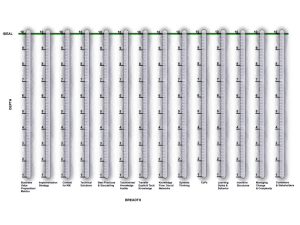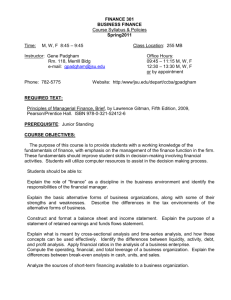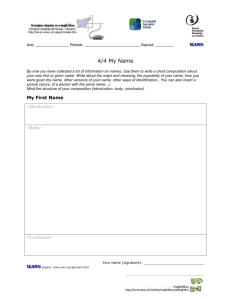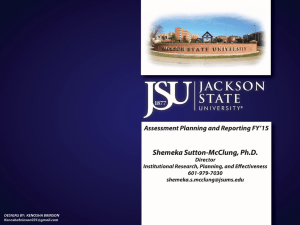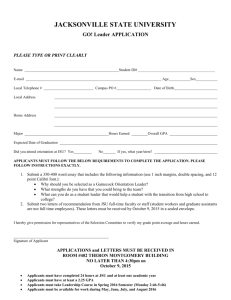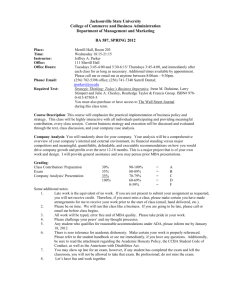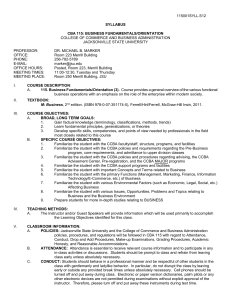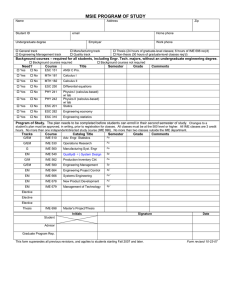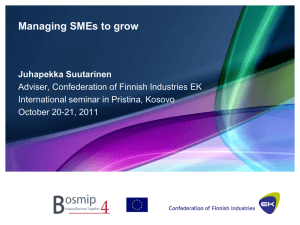Design and Corporate Identity
advertisement
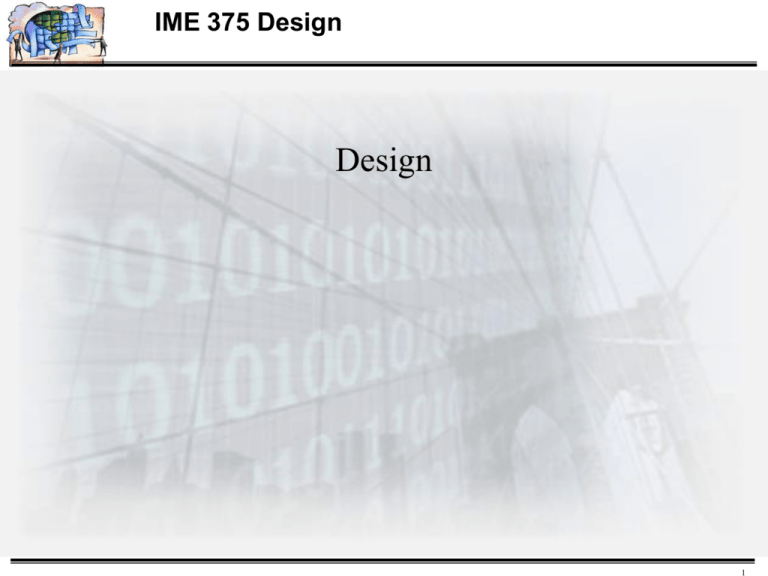
IME 375 Design Design 1 IME 375 Design Client Logo Introduction to Digital Design: This topic is unique in that its not technical but applies to technical and non-technical people alike. Designers have the responsibility of creating a webpage that captures the imagination of the user while presenting the requested information in an easy to understand format. This is a daunting task given the increase in web technologies that developers like to showcase (i.e. Flash, JavaScript, DHTML, XML and multimedia). Digital Design is about the information architecture of a website, can a user find what they are looking for quick and easy all while feeling like they’ve spent time interacting with the firm’s desired experience. 2 IME 375 Design [Stanford Persuasive Technology Lab] found that when people assessed a real Web site's credibility they did not use rigorous criteria, a contrast to the findings of Consumer Reports WebWatch's earlier national survey, A Matter of Trust: What Users Want From Web Sites, released April 16, 2002. The data showed that the average consumer paid far more attention to the superficial aspects of a site, such as visual cues, than to its content. For example, nearly half of all consumers (or 46.1%) in the study assessed the credibility of sites based in part on the appeal of the overall visual design of a site, including layout, typography, font size and color schemes. 3 Content Design Technology 4 Web Site Evolution Web Site Evolution 1. Electronic Brochure Site Model • Content coded into the Web page HTML code, any changes to content required that the Web site code itself be updated. Work flow --> one viewable page at a time. Any change to site design, content or code, required that one or more developers be involved in a mini (or sometimes major) development project. Labor-intensive and time-consuming --> doesn't scale well. Knowledge of html or html publishing tool required to publish. Minimal cohesive visual consistency and user interface design. • • • • 5 Web Site Evolution 6 Web Site Evolution • 2. "E-Commerce" Web Site Model • Body of relatively static information. • Technical knowledge needed to publish. • But more complex than brochure site. Addition of: – – – – – Virtual includes Stylesheets Forms Shopping cart functions. Main focus at this stage of the web sites evolution was the addition of dynamic transaction capabilities. – etc. 7 Web Site Evolution 8 Web Site Evolution 3. Web-based Business Application Model or (Dynamic Content Centric Model) • • • • • • • • • • Content driven. Separation of application from content enables content to be freely added to a site without affecting the design, and allows redesign to occur without impacting on content. An automated publishing process allows content creators throughout an enterprise to create and contribute their own content to a Web site without relying on technical resources. Content can be submitted to the Web sites directly from within their browsers. Content and design elements of the Web site are stored in a relational database on a server. The Web pages are created dynamically as they are requested. Allows contributors who have little or no technical knowledge about web site construction and design to contribute easily to a site and to manage contributions from their web browser. Automated content management. Ease of frequent content updates. Information is classified correctly and fits into an overall information architecture. Information can be personalized for specific users or user groups. Layout and visual design of pages is consistent and of the quality required. Treats the content as application data that can be altered as needed without any need to modify the underlying site. 9 Web Site Evolution 10 Methods of Evaluating Sites Criticism judges quality through close reading, introspection and taste. Criticism, when practiced with care and consideration, can yield subtle insights and answer complex questions no other method can match. On the other had, critical judgments are inevitably open to censure as arising from personal affection (or affectation), idiosyncrasy, political affinity, or poor judgment. Subjective. Usability studies judge quality by measuring the performance of a document, in actual use, against conventional figures of merit. How quickly can readers find facts in the hypertext? How well do they score on tests? Do readers report liking or disliking their encounter with the work? Strives for objectivity. Source: http://www.eastgate.com/HypertextNow/archives/Merit.html 11 Methods of Evaluating Sites The Web, we can argue, is a vast marketplace whose currency is attention: • Effective Web sites are those that gain and hold an audience. • An unusable Web site should also be unpopular; • A site's ability to gain and hold an audience might be viewed, in effect, as a large-scale usability experiment. • Similarly, some people judge the quality of published works by their sales figures. • A best-seller, some think, is bound to be better than a less-read title. We might measure a Web site's effectiveness by bottom-line performance: • how much product does a commercial Web site sell? • How many adherents does an issueoriented Web site recruit? • Where it applies, the performance metric is indeed attractive. • we might instead measure the amount of time readers spend examining a Web site. 12 Methods of Evaluating Sites In the final analysis there is ONE primary thing to consider. CUSTOMER CENTRIC DESIGN 13 Performance Ease of use Brand Value Customer Centric Design Content Satisfaction 14 Design and Corporate Identity • “Corporate Identity” is the result of all impressions that the organization makes on its employees, customers, and everyone who interacts with it. • Users need a strong and consistent sense of place. • A web-site should be consistent, well-edited and organized around a congruous visual design and content theme. • In strong identity programs, everything is an expression of the overall design system and always designed and understood within the context of the larger goals of the institution. • Effective identity programs have two goals: to communicate the purpose of the enterprise both internally and externally, and to create a sense of common purpose for those who work with the organization. 15 Design and Corporate Identity 16 Design and Corporate Identity 17 Design and Corporate Identity 18 Design and Corporate Identity • Web-based identity programs should have three basic aims: – Coherence: presents the enterprise as clearly and comprehensively as possible. – Symbolism: provides functional evidence of social cohesion and purpose. – Positioning: A clear and recognizable identity program helps distinguish an enterprise from peers and competitors. 19 Customer Centric Sites University sites http://www.jsu.edu/depart/ccba/featherstone/index.htm http://www.jsu.edu/ http://www.phoenix.edu/ http://www.scu.edu.au/ http://www.wsu.edu/ ===================== http://www.harvard.edu/ http://www.yale.edu/ http://www.uchicago.edu/ http://www.stanford.edu/ http://www.umich.edu/ BUSINESS-SCHOOLSs http://www.hbs.edu/ http://www.bus.umich.edu/ http://www.wharton.upenn.edu/ http://www.kellogg.northwestern.edu/ http://www.gsb.stanford.edu/ http://www.london.edu/ http://www.jsu.edu/depart/ccba/ DESIGN SCHOOLS http://www.risd.edu/ http://www.scad.edu/ 20
